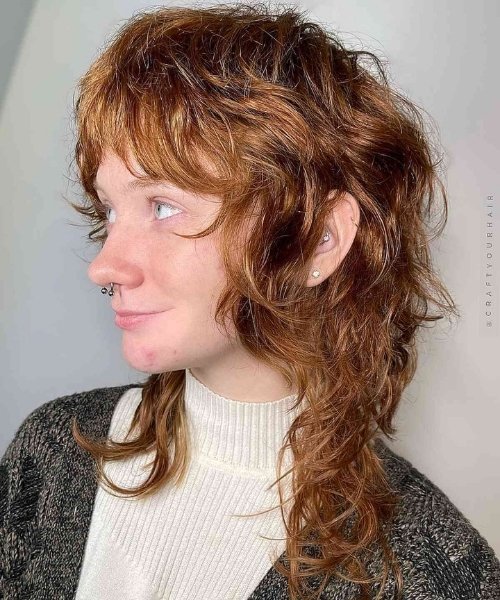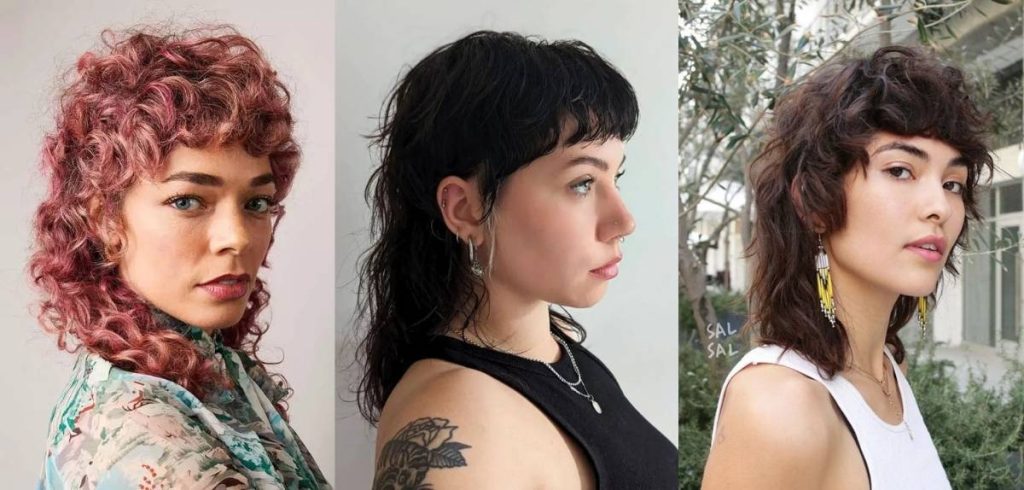It’s official — shaggy hair is back, and it’s bigger (and messier) than ever. The wild, undone looks of the 70s and 80s are having a full-blown revival, showing up everywhere from red carpets to TikTok feeds. Today’s trends prove that “perfectly imperfect” hair is here to stay — and nothing says that better than the wolf cut and the mullet.
At first glance, they seem almost identical — both are layered, tousled, and a little rebellious. But here’s where most people, even stylists, get mixed up. The wolf cut and the mullet may share the same DNA, but they’re built differently. One celebrates blended volume and texture; the other thrives on sharp contrast and edge.
In this showdown, we’ll break down what sets these iconic cuts apart — from their history to how they shape your face and style vibe — so you can decide which one’s calling your name.
The Classic Mullet: Business in the Front, Party in the Back

Before it became the go-to haircut of rock legends, the mullet had a surprisingly practical past. Ancient warriors wore it to keep their necks warm while still seeing clearly in battle — a mix of function and flair. But it wasn’t until the 1980s that the mullet earned its pop culture crown. Think David Bowie’s Ziggy Stardust, Billy Ray Cyrus, and every rock or country star who made the phrase “business in the front, party in the back” sound like a lifestyle.
What defines a mullet is its drama. The front and sides are short — sometimes even buzzed or faded — while the back flows long, creating a sharp disconnection. Unlike today’s heavily layered styles, a classic mullet keeps the back length mostly intact, giving it that distinct, edgy silhouette. It’s bold, loud, and unashamedly retro — a haircut that makes a statement before you even say a word.
The Modern Wolf Cut: Shag Meets Mullet

The wolf cut is what happens when a 70s shag and an 80s mullet fall in love — a perfect mix of structured chaos and soft volume. While the mullet screams contrast, the wolf cut whispers texture. It blends heavy, choppy layers throughout the head to create that full, slightly wild look that feels effortless and modern.
Unlike the mullet’s sharp disconnection, the wolf cut is all about blending. The sides melt naturally into the back, keeping the movement continuous. It also frames the face beautifully — usually with curtain bangs or a messy fringe that softens the overall shape. This makes it flattering for many face types and easy to adapt for straight, wavy, or curly hair.
The style took off in the early 2020s thanks to TikTok and K-Pop idols like Choi Beomgyu of TXT and Lisa from BLACKPINK. Their voluminous, untamed layers made the wolf cut the symbol of carefree cool — part edgy, part romantic. It’s less “rock concert in the 80s” and more “street style with a hint of rebellion.”
Key Differences: The Layering Blueprint
When you see a wolf cut and a mullet side by side, they might seem like twins — but they’re more like siblings with totally different personalities. The secret lies in how the hair is cut and layered.
1. Contrast vs. Texture
The mullet is all about contrast. It has a short, cropped front and sides that lead abruptly into a long, flowing back. The difference in length is sharp and noticeable — that’s what gives it its iconic “split” look. The wolf cut, on the other hand, focuses on texture and volume. Instead of a harsh divide, the layers are heavily chopped and feathered, giving the hair a soft, lived-in shape that grows out beautifully.
2. Face Framing
If you love face-framing layers, the wolf cut wins hands down. It always includes wispy bangs or shag-style layers that highlight your eyes and cheekbones. The mullet usually skips this step, keeping the fringe shorter or minimal for a cleaner, bolder front.
3. Maintenance and Grow-Out
Here’s where practicality comes in. The mullet needs regular trims to keep that crisp, disconnected shape intact. Miss a few appointments, and it can lose its punch quickly. The wolf cut is far more forgiving — the layers grow out naturally, shifting into a soft, long shag that still looks intentional months later.
Who Should Choose Which Cut? (Suitability Guide)
Choosing between the wolf cut and the mullet really comes down to your hair type, face shape, and personality. Both styles are statement-makers — but they speak different languages.
1. Hair Texture & Density
If you’ve got medium to thick hair, especially with a natural wave or curl, the wolf cut will be your best friend. Its layered structure helps remove bulk while enhancing movement and bounce. For straight or fine hair, the mullet often works better. Its distinct silhouette gives the illusion of volume and structure where your strands might fall flat otherwise.
2. Face Shape
The wolf cut’s soft, curtain-style layers flatter oval, round, and heart-shaped faces, drawing attention to the eyes and cheekbones. The mullet, with its sharper lines and shorter sides, suits square or angular faces, balancing stronger jawlines and adding length to the face.
3. Personal Style
If your style leans modern, artistic, or low-maintenance, the wolf cut nails that effortless vibe — perfect for those who want movement without too much styling. But if you crave bold, unapologetic, and vintage-inspired energy, the mullet is your go-to. It’s for people who don’t just follow trends — they set them.
Conclusion
So, wolf cut vs. mullet — which wins? Honestly, neither. It all depends on your vibe. The wolf cut is the softer, modern evolution of the shag — full of texture, volume, and a touch of rebellion that looks great even as it grows out. The mullet, meanwhile, keeps its roots in pure attitude — sharp, bold, and unapologetically retro.
If you take one thing away, let it be this: the wolf cut is blended, while the mullet is disconnected. Both have personality, both turn heads, and both can be tailored to fit you.
Before booking your next salon visit, bring reference photos and talk to your stylist about layering and face framing — not just the haircut name. Because in the end, the best cut isn’t about following the trend; it’s about owning the version that feels most you.
FAQs: Wolf Cut vs. Mullet
1. Is a wolf cut just a type of mullet?
Not exactly. The wolf cut borrows the mullet’s short-to-long shape but mixes it with heavy shag-like layers. The result is softer and more blended — less “business in the front, party in the back,” and more effortless, tousled texture.
2. Which haircut is easier to maintain — wolf cut or mullet?
The wolf cut is easier. Its layers grow out naturally, keeping a flattering shape for months. The mullet needs more frequent trims to preserve its crisp, disconnected sides and longer tail.
3. Does a wolf cut work on straight hair?
Yes, but it shines most on wavy or thick textures. On straight hair, it might need some styling — think a curling iron or texture spray — to bring out that signature volume and movement.
4. Which haircut gives more volume?
The wolf cut wins here. Its choppy, all-over layering builds volume at the crown and throughout the length, while the mullet keeps most of the volume concentrated in the back.
5. Can I combine a wolf cut and a mullet?
Absolutely. Many modern styles blur the lines between the two — a “wolf mullet” or “soft mullet” blends the layered crown of a wolf cut with the longer tail of a traditional mullet for a trendy, wearable hybrid.
